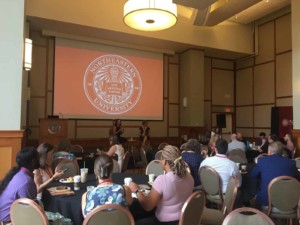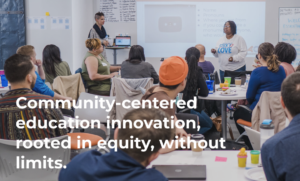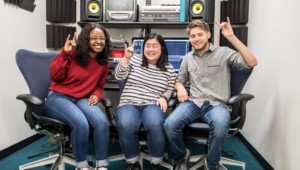'Innovation' Push Raising Questions
EdWeek ran a good summary of tensions around the innovation agenda. Full text below:
School leaders are under increasing pressure to “innovate.”
The word is ricocheting around Washington, emanating from the White House, the U.S. Department of Education, and numerous reports and conferences convened by those who hope to influence the direction such ventures take.
President Barack Obama’s call for innovation to improve the nation’s schools strikes a chord with many in policy circles, who are already discussing how the federal government can play a role not only in supporting the expansion of what works, but also in creating solutions to unsolved problems.
But some experts are pointing out that significant barriers inhibit real innovation in education. And others question whether “innovation” is really what schools need.
In a March paper titled “Innovation, Motherhood, and Apple Pie,”![]() Grover J. “Russ” Whitehurst, the director of the Brookings Institution’s Brown Center on Education Policy, took aim at the hubbub around innovation. He cautioned against forgetting that there are effective and ineffective innovations.
Grover J. “Russ” Whitehurst, the director of the Brookings Institution’s Brown Center on Education Policy, took aim at the hubbub around innovation. He cautioned against forgetting that there are effective and ineffective innovations.
“Unless effectiveness is thought of as a central dimension of innovation, the current innovation zeitgeist will subject the nation to yet another era of fad and fancy in education, rather than continuous improvement,” warned Mr. Whitehurst, who was the director of the Education Department’s Institute of Education Sciences under President George W. Bush.
Similarly, thinkers at the Center for American Progress and the American Enterprise Institute, both based in Washington, are worried about the press for innovation and its cousin, entrepreneurship. In education, barriers including rigid bureaucracies, lack of access to capital, and limited supply of talent may stifle innovation, they write in a paper released this month.
The Obama administration recently announced a Social Innovation Fund, which seeks to identify “the most promising, results-oriented nonprofit programs” and help them expand nationwide. The fund has three priority areas: education, health care, and economic opportunity. It will be overseen by the White House’s new Office of Social Innovation and Civic Participation.
The president has asked for $50 million in his fiscal 2010 budget as “growth capital” for the fund, and expects philanthropies and corporations to contribute money and technical assistance.
Separately, the American Recovery and Reinvestment Act, known as the stimulus bill, includes a $650 million “innovation” fund to facilitate the scaling-up of promising education reforms.
In a new paper, two Washington think tanks explore what they describe as the difficulty that “providers” of education, some offering innovative solutions, have in getting a foothold in the system. They offer the following advice to pave the way for these entrepreneurial solutions.
Meanwhile, proposed education legislation on Capitol Hill calls for “innovation” to improve high schools. The Secondary School Innovation Fund Act, introduced in the U.S. Senate on May 4, with a companion bill in the House, would establish a permanent fund to support partnerships to scale up successful high school improvement strategies.
Jobs For the Future, a Boston-based nonprofit group that advocates improved college and work preparedness for young people, convened influential policymakers and practitioners in Washington last week to begin shaping guidelines for innovation at the high school level for the Obama administration.
Marlene B. Seltzer, the president of JFF, told the group that the president’s budget priorities and initiatives signal a propitious time for real advances in school improvement.
“This is an unprecedented time in our history,” Ms. Seltzer said. “All the stars are aligned. Collectively, we have a huge opportunity.”
Richard Kazis, JFF’s senior vice president, said in an interview that he hoped the assembled brain trust could help guide the administration in boosting the “supply side” of school reform in two ways: by expanding promising strategies to more places, and by inventing new solutions for problems still unsolved.
“The policy has been pressure to see where the weaknesses are and improve,” he said. “But unless you have a ‘supply side’ strategy that says, ‘Here are some of the things that work,’ you have only one part of the solution. The trick is, how do we keep pressure on to make visible where the problems are, and at the same time encourage innovation and development of new things?”
Just as the word “innovation” crosses the lips of dozens in policy circles, however, it is prompting reality checks, even from some of those who support the idea.
Michael D. Casserly, the executive director of the Washington-based Council of the Great City Schools, which represents 66 of the country’s largest districts, said district leaders see a tension between the Obama administration’s emphasis on innovation and the conditions imposed on some of the federal stimulus money that can be spent in its service.
“They’re being encouraged to innovate on the one hand, and constrained on the other by strings that make it hard to free up some of the money to innovate,” Mr. Casserly said. “They welcome the money, to be sure, but the public shouldn’t think school districts all over the country are getting huge checks with no strings attached, or that there is unfettered use to do all kinds of interesting and innovative things with it.”
And even if school leaders were to have plenty of money to use, some experts worry that numerous barriers make real innovation impossible.
The recent paper by the Center for American Progress and the American Enterprise Institute, for instance, argues for “clearing obstacles that hinder entrepreneurial innovation” in education. The groups called on federal, state, and district leaders to commit to a wide range of policy changes in support of innovation and entrepreneurship.
“The current and potential new entrepreneurs are stifled by several unnecessary and outdated state and district policies, and an education system that remains as a whole insensitive to performance and quality,” said the report, “Stimulating Excellence: Unleashing the Power of Innovation in Education.”
The two organizations argued, among other things, for federal and state policy changes to facilitate data gathering and use, to open the education world more to diverse providers such as charter school operators and alternative-teacher-certification groups, to allow districts and schools greater control over their money, and to encourage public financing of education entrepreneurs.
Mr. Whitehurst expressed concern in his paper that new federal innovation grants will be biased toward those who propose innovations in “product”—virtual schooling, for instance—rather than “process” innovations that improve education’s efficiency, functionality, productivity, or customer satisfaction.
It is important, he argued, for the administration to “create a level playing field” for both.
Michael J. Petrilli, who helped oversee implementation of the public-school-choice and tutoring provisions of the No Child Left Behind Act in the Department of Education’s office of innovation and improvement, thinks proponents of a greater federal role in innovation overestimate the government’s capacity to eliminate the barriers to creating new approaches to schooling.
And by setting itself up as a driver of innovation, he said, the Obama administration risks having its education aims undermined by those who may see its choices as motivated by cronyism.
“The problem with saying that the government is going to invest [in innovations] like a venture philanthropist is that government decisions are inherently political, or at least people are always going to assume they are political, which makes it very difficult for those programs to succeed,” said Mr. Petrilli, who is the vice president for national programs and policy at the Thomas B. Fordham Institute in Washington. “This could blow up in the administration’s face.”






0 Comments
Leave a Comment
Your email address will not be published. All fields are required.